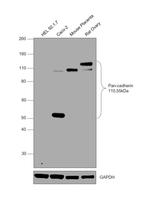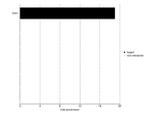Search Thermo Fisher Scientific
FIGURE: 1 / 2
Pan-cadherin Antibody (MA5-15036) in WB


Product Details
MA5-15036
Species Reactivity
Published species
Host/Isotype
Class
Type
Clone
Immunogen
Conjugate
Form
Concentration
Purification
Storage buffer
Contains
Storage conditions
Shipping conditions
RRID
Product Specific Information
It is not recommended to aliquot this antibody.
Target Information
Pan Cadherin including CDH1, CDH2, CDH3, CDH4 protein belong to a family of transmembrane molecules that mediate calcium-dependent intercellular adhesion. Cadherins are involved in controlling morphogenetic movements during development and regulate cell surface adhesion through homotypic adhesion with the same cadherin species. N-cadherin's function is dependent on its association with the actin-cytoskeleton and is mediated through interactions between the C-terminal region of N-cadherin and the cytoplasmic catenin proteins. The stability of this association is regulated by phosphorylation and dephosphorylation of beta-catenin.This gene is a classical cadherin from the cadherin superfamily. The encoded protein is a calcium dependent cell-cell adhesion glycoprotein comprised of five extracellular cadherin repeats, a transmembrane region and a highly conserved cytoplasmic tail. The protein functions during gastrulation and is required for establishment of left-right asymmetry. At certain central nervous system synapses, presynaptic to postsynaptic adhesion is mediated at least in part by this gene product.
For Research Use Only. Not for use in diagnostic procedures. Not for resale without express authorization.
Bioinformatics
Protein Aliases: ARC-1; cadherin 1, E-cadherin (epithelial); cadherin 1, type 1; cadherin 1, type 1, E-cadherin (epithelial); cadherin 2 type 1 N-cadherin (neuronal); cadherin 2, type 1, N-cadherin (neuronal); cadherin 3, type 1, P-cadherin (placental); cadherin 4 type 1 R-cadherin (retinal); cadherin 4, type 1, preproprotein; cadherin 4, type 1, R-cadherin (retinal); cadherin e; Cadherin-1; Cadherin-2; Cadherin-3; Cadherin-4; cadherin-E; calcium-dependent adhesion protein, epithelial; calcium-dependent adhesion protein, neuronal; calcium-dependent adhesion protein, placental; CAM 120/80; CD324; CD325; CDw325; CDw325 antigen; cell-CAM 120/80; E-Cadherin; E-cadherin 1; Epithelial cadherin; N-cadherin; N-cadherin 1; Neural cadherin; P-cadherin; Pan Cadherin; Placental cadherin; Placental-cadherin; R-CAD; R-cadherin; retina cadherin; Retinal cadherin; RPE-specific cadherin; Uvomorulin
Gene Aliases: AA960649; AI385538; Arc-1; AW120700; CAD4; Cadp; CD324; CD325; CDH1; CDH2; CDH3; CDH4; Cdh4l; CDHE; CDHN; CDHP; CDw325; E-cad; ECAD; HJMD; L-CAM; LCAM; N-cadherin; NCAD; P-cadherin; PCAD; R-CAD; R-Cadh; R-cadherin; RCAD; Um; UVO
UniProt ID: (Human) P12830, (Human) P19022, (Human) P22223, (Human) P55283, (Mouse) P09803, (Rat) Q9R0T4, (Mouse) P15116, (Rat) Q9Z1Y3, (Mouse) P10287, (Mouse) P39038
Entrez Gene ID: (Human) 999, (Human) 1000, (Human) 1001, (Human) 1002, (Mouse) 12550, (Rat) 83502, (Mouse) 12558, (Rat) 83501, (Rat) 116777, (Mouse) 12560, (Mouse) 12561, (Rat) 114588

Performance Guarantee
If an Invitrogen™ antibody doesn't perform as described on our website or datasheet,we'll replace the product at no cost to you, or provide you with a credit for a future purchase.*
Learn more
We're here to help
Get expert recommendations for common problems or connect directly with an on staff expert for technical assistance related to applications, equipment and general product use.
Contact tech support
